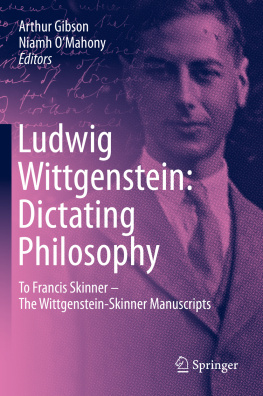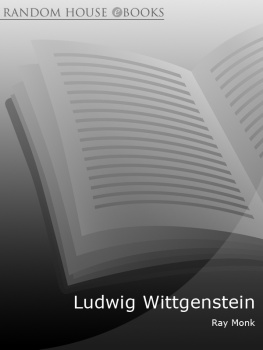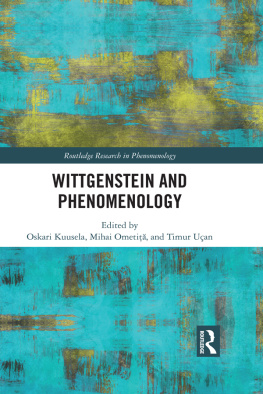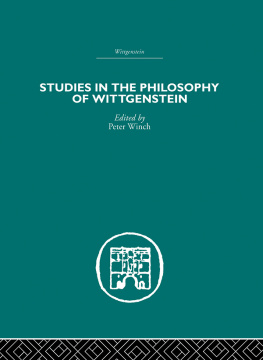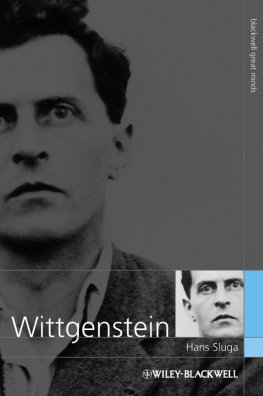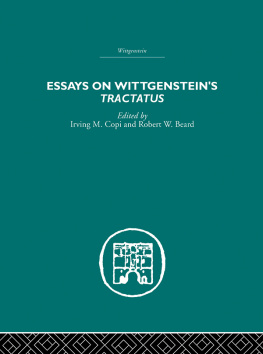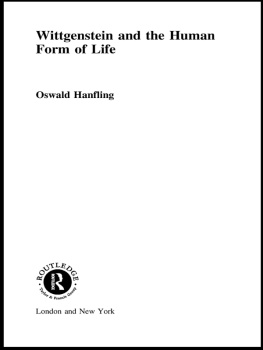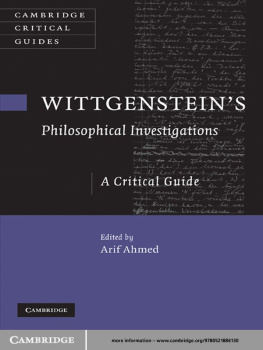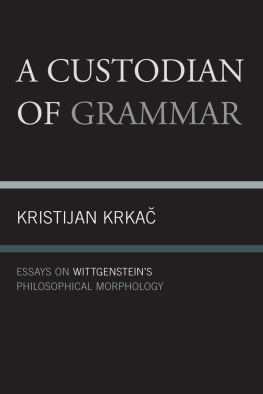Editors
Arthur Gibson
Department of Pure Mathematics and Mathematical Statistics, Centre for Mathematical Sciences, University of Cambridge, Cambridge, UK
Niamh OMahony
Cambridge, UK
ISBN 978-3-030-36086-3 e-ISBN 978-3-030-36087-0
https://doi.org/10.1007/978-3-030-36087-0
This book is published as a special edition of the Nordic Wittgenstein Studies with the website of the series.The cover uses photos of Wittgensteins amanuensis, Francis Skinner, are virtually unknown. This hitherto unknown one from 1936, kindly retrieved by his family, needed extensive restoration for it to be publishable. We are grateful to the mathematician Dr Simone Parisotto, for achieving this outcome so faithful to the original amid his research at the Cambridge Mathematics Faculty and Fitzwilliam Museum.
Springer Nature Switzerland AG 2020
This work is subject to copyright. All rights are reserved by the Publisher, whether the whole or part of the material is concerned, specifically the rights of translation, reprinting, reuse of illustrations, recitation, broadcasting, reproduction on microfilms or in any other physical way, and transmission or information storage and retrieval, electronic adaptation, computer software, or by similar or dissimilar methodology now known or hereafter developed.
The use of general descriptive names, registered names, trademarks, service marks, etc. in this publication does not imply, even in the absence of a specific statement, that such names are exempt from the relevant protective laws and regulations and therefore free for general use.
The publisher, the authors and the editors are safe to assume that the advice and information in this book are believed to be true and accurate at the date of publication. Neither the publisher nor the authors or the editors give a warranty, expressed or implied, with respect to the material contained herein or for any errors or omissions that may have been made. The publisher remains neutral with regard to jurisdictional claims in published maps and institutional affiliations.
The cover uses photos of Wittgenstein's amanuensis, Francis Skinner, are virtually unknown. This hitherto unknown one from 1936, kindly retrieved by his family, needed extensive restoration for it to be publishable. We are grateful to the mathematician Dr Simone Parisotto, for achieving this outcome - so faithful to the original - amid his research at the Cambridge Mathematics Faculty and Fitzwilliam Museum.
This Springer imprint is published by the registered company Springer Nature Switzerland AG
The registered company address is: Gewerbestrasse 11, 6330 Cham, Switzerland
Plate 1 Wittgensteins amanuensis and friend, Francis Skinner, summer 1936, at the wedding of Francis sister. (The effects of the metal leg brace due to polio show on Francis outer right trouser leg. See also Appendix [Q] for Francis sisters notes on him.) We are grateful to the Skinner family for retrieving this photograph. (Published images of Wittgensteins amanuensis, Francis Skinner, are virtually unknown. The condition of this rare 1936 photograph of Francis Skinner needed extensive restoration for it to be publishable. We are grateful to Mathematician Dr. Simone Parisotto for achieving this so faithfully to the original, amid his research at the Cambridge Mathematics Faculty and Fitzwilliam Museum.)
Foreword
Arthur Gibson was the first to recognise the importance of the new discovery of the Wittgenstein-Skinner hitherto unpublished Archive. He deserves many congratulations on the publication. Its contents enable us (or rather primarily him) to reconstruct a whole phase in Wittgensteins philosophy. His Introduction is exemplary and provides new ways forward to generate future insights. Professor Gibson affords us fresh insights into Wittgensteins methods of composition, of thought, and particularly reveals what Wittgensteins difficulties with mathematics were; but that this could all only (or best) be done by someone with Gibsons breadth of skills and ability to pull in a relevant insight from remote areas. This book throws so much light on a crucial period of the development of the work and the publishing plans of Wittgenstein. It is very revelatory of his attitude towards processes of creative collaboration and even friendship.
The book abounds with good qualities: this Editions transcriptions of the original manuscripts; its profound, original yet accessible Introduction; the informative importance of its footnotes, also for their evidence signalling Wittgensteins thought processes; the wide range of valuable, hitherto inaccessible as well as new ranges of information and insights in its Appendices all amount to a treasury for readers, and for further understanding of the subject.
In Cambridge, Professor Gibson has, in effect, crafted his own informal research phrontisterion. His expertise and researches, which have conquered areas of the learned world sometimes in a dramatic manner, are spread across subjects and faculties. This focus reflects aspects of the importance of his own original researches in a range of subjects, which also can be brought to bear on Wittgenstein, as witnessed in the present book. Various authorities and his colleagues in diverse subjects have celebrated and highlighted aspects of this picture. Bernard Williams stated, Arthur Gibson is a philosopher of significant international distinction at the very least. Considering Wittgensteins engagement (e.g. in Chap. ), and others. In assessing how Wittgensteins writings in the present book inform twenty-first-century debates, it is worth reading another of the Editors books, which engages with such concerns as Metaphysics and Transcendence. Notice the view of its publishers (Routledge) anonymous Continental referee, stating that This book is outstanding and of major significance. It is a distinguished and important contribution to the subject, as well as original writing of high order...a product of a mature and deep mind. It falls into that class of both surprising potential and quality that could outstrip Foucault. Frank Kermode, who over years researched with the Editor on numerous subjects, concluded: Arthur Gibson combines a temperament as cheerful as a good open coal fire with a mind like a pressure cooker He is a Renaissance manand a genius.
This Edition is also fortunate to benefit from its other Editor, Niamh OMahony, not least with her expertise as a sometime Trinity College Cambridge Russianist researcher and a former writer, researcher and reviewer on the staff of the BBC Russian Service, which place her in an expert position to guide us. This is evidenced by her impressive new translations of the Pushkin poems (see Appendix [J]) poems that Wittgenstein utilized and copied out by hand in Russian; they appear immediately after the time of Skinners death. Valuable is the way, for example, in which the Edition incorporates OMahonys presentation of the newly discovered (Trinity) Pat Sloan Moscow letter about Wittgenstein (Appendix [R]). These draw on her published research and lecturing on the subject (cf. OMahony 2013). Even OMahonys and Gibsons original gathering and interpretation of apparently secondary resources for example, the first publication of the ancestry of Francis Skinner (Appendix B), which launches and facilitates new initiatives are of considerable value for future research.

